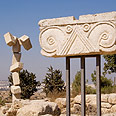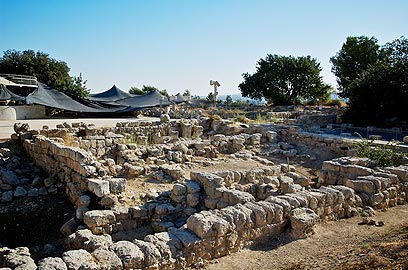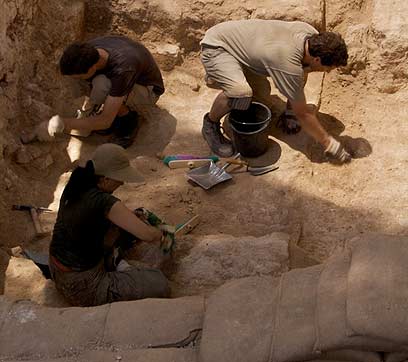
Iron Age walls intrigue archaeologists at Ramat Rachel
German Christians, Jewish Israelis work together to discover excavation site’s history, building lasting friendships in the process
Among the many finds this year archaeologists discovered the continuation of the Iron Age citadel at the site originally excavated by Yohanan Aharoni in the 1950’s, the first proof indicating that Ramat Rachel during the last 125 years of the First Temple Period was larger and more important than previously thought.
The Iron Age citadel is the earliest construction at Ramat Rachel, from around the latter half of the First Temple Period.
“We have a nice continuation from the Iron Age to Persian periods,” Lipschits said of the citadel remains, “but it’s still difficult to tell exact dates of the different phases.”
Understanding the dating and origins of the citadel would help archaeologists know why the site was originally built, by whom, and what purposes it served.
Lipschits believes that Ramat Rachel was founded just after the invasion of Sennacherib in 701 BCE. According to the account in 2 Kings chapter 18, all the fortified cities of Judah were destroyed by the Assyrians, except for Jerusalem.

Excavation site (Photo: Will King)
With its commanding view over much of upper Judah and strategic position along the main road from Jerusalem to Hebron, Lipschits believes that Ramat Rachel was the perfect place for the new Assyrian rulers to have a palace and administrative center for collecting taxes from throughout Judah.
Subsequent foreign rulers, such as the Babylonians, Persians, and Romans, then used the site for the same purposes. According to Lipschits, approximately 85% of all Persian Period YEHUD stamp impressions in Judah have been found at Ramat Rachel, some 280 of them, adding to the belief that the site was an important administrative center.
Strong evidence of Jewish settlement
This year archaeologists discovered continuations of the walls of the Iron Age citadel on all four sides, meaning that the palace complex was much larger than previously thought and had been built in at least two phases.
Fertile garden soil from the Refaim Valley below was also found in great quantity in the areas in and around the palace complex indicating that there were lush gardens there as well.
The palace was also richly decorated, as ten of a total eleven Proto-Aeolic (also known as Proto-Ionic) capitals from seventh century BCE Judah have been found at Ramat Rachel alone. A corner piece of a Proto-Aeolic capital was unearthed this season by a volunteer, but archaeologists still need to check if it is part of a new capital or a piece of a previously discovered one.
There’s also strong evidence of Jewish settlement at Ramat Rachel sometime in the second century BCE after the citadel was destroyed. About a dozen mikvaot (Jewish ritual baths) have been discovered dotted around the site, including one that was cut at great effort from flint stone.
This season a hoard of several silver coins, similar to ones used in the temple, were found inside of a cooking pot and hidden deep in a niche inside a columbarium, a cave used for raising pigeons. The coins date to around the time of the destruction of the Second Temple in 70 CE.
Different perception of the Bible
But what makes the Ramat Rachel dig so unique are the students and volunteers that dig at the site. The excavations are a joint project between Tel Aviv University and Heidelberg University in Germany.
Most of the German students are majoring in theology, and some will eventually go on to become pastors at various churches throughout Germany. At Ramat Rachel the German Christians and Jewish Israelis work together to discover the site’s history, and in the process build lasting friendships.
Dr. Manfred Oeming, co-director of the dig and professor of theology at Heidelberg University, has led more than 100 of his students at Ramat Rachel over the last four seasons of excavations.
When asked why he felt it was important for theology students to excavate in Israel, Oeming said, “I’m sure some of my students will have a totally different perception of the Bible when they are excavating and feeling things for themselves.”

Working together (Photo: Will King)
One of the Heidelberg theology students, Friedrich-Emanuel Focken, said, “It’s very nice to have this experience so close to Jerusalem and with this group of people.” Focken, who participated in the field archaeology class offered by Tel Aviv University at the site, said that he plans to return again next year.
“Some people are here for the second, third time not by coincidence I think. For me, “ Oeming said, “this is a very important part of our project.” Lipschits agreed saying, “I hope more of the German students will come next year as well.”
In addition to the Germans, students and volunteers came from several other nations, including Canada, the US, Australia, England, Colombia, France, and the Czech Republic.
Tom Engel, a secondary school teacher in Birmingham, England, volunteered for one week as part of his month-long trip around Israel. “It was really good, I enjoyed it. It’s a challenge,” Engel said, “but the best part has been the people. It makes all the hard work worthwhile.”
Lipschits says that next season they plan to conduct a thorough survey of the area surrounding the tel and to excavate several terraces and agricultural instillations. However, the main focus will be to further expose the continuations of the Iron Age walls in order to discover the size and origins of the site. According to Lipschits,
“This is something that I think will add a new direction to the excavations next year.” The fifth and final scheduled season of the Tel Aviv-Heidelberg excavations at Ramat Rachel is set to begin July 20, 2009.










